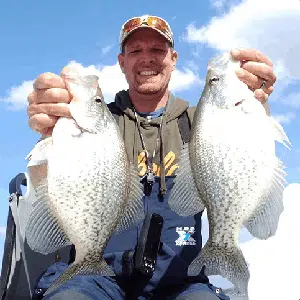PLEASE SHARE
WE ARE YOUR SOURCE FOR FISHING DESTINATIONS IN ALABAMA!
Fall Patterns for Crappie on Weiss Lake

Some of the best fishing weather comes in October, November and December. Guide Tim Pentecost reveals the best fall patterns for catching crappie.
By Eileen Davis
Winning tournament angler and successful guide Tim Pentecost targets crappie on Weiss Lake from mid-October through the end of December using two patterns. One is on the main river channel, and the other is along the shoreline.
Main River Channel Pattern
Of the two, the main river channel pattern produces the biggest crappie.
“We catch a lot of big fish on the main river channel,” said Pentecost. “The crappie range in size from 10 inches to 1½ pounds. Last year, we competed in a tournament with a 30-fish limit. Our bag weighed 31 pounds and some were two pounders.”
While this pattern usually begins in mid-October, Pentecost says the key is water temperature. As the water cools, shad and crappie migrate from the flats to the main river channel. It’s possible to find fish on the submerged channel in September, but the migration is not complete until the water temperature falls below 70 degrees.
When conditions align, Pentecost says fishing the main river channel offers fast action.
He continued, “Some days fishing is slow, but there are days when you cannot keep your lines in the water. On days like that, you have to hit spot lock on the trolling motor, remove all the fish from your lines, then reset your rods and start again.”
To find crappie, Pentecost concentrates on fishing mid-lake between Yellow Creek and Bay Springs. He avoids areas on the main river channel with a steep drop off.
“Steep drop-offs do not produce as well as places where the submerged river bank slopes into the channel. A gradual slope has more cover and steps. Small stumps that you can barely see with LiveScope will hold two or three fish.”
Once on a promising stretch of river channel, Pentecost’s hunt for crappie involves pushing bottom-bouncing double minnow rigs with six spider rigged rods. The technique is also known as tight lining, and the terminal gear as a drop shot. His rig has a ¾-ounce bell sinker at the end of the line with a 6-inch leader attached 12 to 15 inches above the sinker. A second 6 inch leader is attached 12 to 15 inches above the bottom leader. Both leaders sport No. 2 hooks. All lines are 10-pound K9 Hi-Vis Fluoro, and the rigs are fished on 16-foot Pro SE Outlaw Crappie Poles with Outlaw spinning reels.
Pentecost’s double minnow rig is effective for two reasons. It allows him to stay in contact with the bottom and fish two different depths at the same time.
“Most of the time during the day,” he said, “crappie sit in the mud on the bottom. You cannot see them, not even with LiveScope. Sometimes when we catch them, the scales on their bellies are stained or dirty. I prefer to find crappie on the bottom. Most anglers will not fish deep, so it’s a great pattern when guiding or when fishing a tournament.
“Start fishing 15 feet deep. Sometimes the fish will be as deep as 30 feet, but most of the time, you will find them about 15 feet deep. I never troll any faster than .3 mph. And I troll against the current to better control my speed.”
Dock Shooting Pattern
“Anglers catch crappie off docks year round on Weiss,” says Pentecost. “In the fall, there are always plenty of crappie on the docks. The average fish is smaller than the ones we catch on the main river channel, but occasionally you will catch a fish weighing 1½ pounds.”
During fall, Pentecost targets docks at the mouths of coves.
“The docks on the main lake are good,” he said, “but the ones at the mouth of coves just off the main lake hold more fish. Look for docks in water at least 10 feet deep with cover. Dock owners on Weiss sink a lot of cover around their docks.”
Pentecost scans the docks with LiveScope. The forward facing sonar reveals if a dock holds fish, their size, location and depth on the dock. “LiveScope took the hunt out of finding crappie on docks,” he said.
Without live sonar, Pentecost shoots his jig as far as possible to the back of the dock and lets it sink to the bottom before beginning a slow retrieve. Often the fish will be near the bottom. If he doesn’t catch one, the next retrieve is higher in the water column. The depth where crappie suspend under a dock can vary, so it’s necessary to experiment to find the fish.
Pentecost’s setup for shooting docks is a 5-foot, 8-inch Outlaw Crappie Pole with an Outlaw spinning reel spooled with 6-pound K9 Hi-Vis Fluoro line. He uses this rod, reel and line combination to shoot a 1/24-ounce Red Rooster jig head dressed with a 2-inch Red Rooster Georgia Razor soft plastic. The guide’s favorite colors are black and chartreuse in stained water and blue glimmer in clearer water. The lighter jig head sinks slower and skips easier than a heavier one.
“The biggest tip I give anglers,” Pentecost said, “is to practice shooting a jig for accuracy. Practice in the yard by shooting a jig into a cup on its side and by shooting under a garage door that is only open 6 inches.”
To book a guided fishing trip with Tim Pentecost on Weiss or Neely Henry lakes, visit his website, Facebook page or call 256-630-5042.
Book your stay with Walcox Point here.
Click here to read more about how successful anglers find and catch Bama’s fish.


